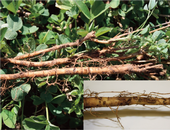- Author: Rachael Freeman Long
- Author: Michelle Leinfelder-Miles
- Author: Sarah LIght
- Author: Rad Schmidt
- View More...

Healthy soils are key for ensuring optimum plant health for high quality, high yielding alfalfa stands, not to mention long-term crop production.
What is meant by 'healthy soils'? Those soils which continually improve in structure, organic matter, aeration, and ability to nurture plant growth are key attributes. Soil 'tilth' is another word for the 'crumbliness' and excellent structure of the soil which allows for good water retention, drainage, fertility, and aeration. To improve soil health we need to address some of the problems commonly seen in alfalfa fields such as compaction, lack of aeration, and poor drainage, which in turn leads to poor root growth and low yield. What are the...
- Author: Michelle Leinfelder-Miles
UC Cooperative Extension and UC Davis will host a Healthy Soils Program field meeting on compost. The meeting will take place on Thursday, July 28th from 10:00am to 11:30am. The meeting will take place off of S. Landi Road, on Roberts Island in the Delta. Presentation topics include how to acquire compost, different types of compost, how compost can improve soil health and mitigate greenhouse gas emissions, and how to apply for cost-share funding. The meeting location is where we are trialing different rates of green waste compost application for potential soil health and alfalfa yield benefits. Preliminary results will be described. Attendance is free, and...
- Author: Madi Hendrick
- Author: Ian M Grettenberger
- Author: Michael Rethwisch
Insecticide resistance in alfalfa weevils is spreading across California
- Author: Michelle Leinfelder-Miles
- Author: Rachael Long
- Author: Rob Wilson
- Author: Ian Grettenberger

I have received a couple calls this year from growers and a PCA about root scarring in alfalfa fields. These observations were a bit of a “head scratcher” for all of us. At one of the fields, I noticed what looked to be a wireworm on the root, so that was throwing me off (Figure 1). Cutworms can also feed on plant roots. The larger instars have been found below the crowns under plant debris, but we didn't find any at this site. I reached out to Farm Advisor Rachael Long to get her thoughts. I had once heard Rachael talk about clover root curculio, and I wondered if it was causing the problem. While we have not confirmed that clover root curculio is present and causing damage in...
- Author: Rachael Freeman Long
- Author: Morgan Doran
- Author: Brooke Latack
- Author: Richard Zinn
- View More...

A question came up from a rancher/farmer about grazing alfalfa seed production fields after seed harvest. Can one safely turn livestock onto alfalfa seed fields or cut and bale the hay for feed after harvesting the seed?
Yes, with the following considerations:
1) Watch for Chemical Residues. Some of the currently registered chemicals used in alfalfa seed production for pest control and desiccation restrict treated plant material from entering the food chain. Be sure to read the pesticide label before allowing livestock to graze or feed on alfalfa hay after a seed crop harvest. For example, alfalfa treated with Reglone, a diquat based...



